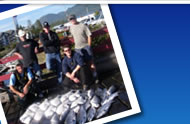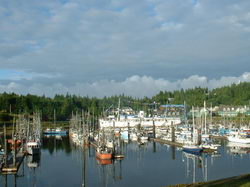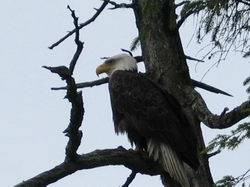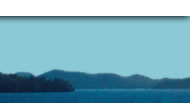

Testimonials
"Thanks again for an incredible adventure. You exceeded our expectations and we will see you next June on the water! |
![]()
 Ucluelet has a population of 1,847 and is situated on a natural harbour.
Ucluelet has a population of 1,847 and is situated on a natural harbour.
It is surrounded by the spectacular beauty of Canada's temperate rainforest and the Pacific Ocean. Some of British Columbia's largest inventories of red cedar stand adjacent to the town. We enjoy a temperate climate with year-round temperature ranges from 5ºC to 20º C. Snowfall is minimal, and we have 328 frost-free days and 1800 hours of sunshine a year. Ucluelet's rain is legendary, less than 50 km from Henderson Lake, the rainiest spot in North America. Fortunately, most of this rainfall occurs during the winter months. It is advised to bring along (or pick up in town) a good rain jacket.
There's a lot to do in this area besides fishing. Popular activities are whale watching, nature cruises, sea kayaking, diving and surfing. Hike the Wild Pacific Trail or check out the beaches and interpretive walks in the Pacific Rim National Park. You can go to the Long Beach Golf Course, Salmon hatchery, aquarium and several art galleries. There's shopping and gift shops in Ucluelet and also Tofino (just a short drive away). Throughout the year there are several annual events including the Pacific Rim Whale Festival (grey whale migration), Pacific Rim Summer Festival (live music from around the world), VanIsle 360 sailboat race, literary readings and art shows.
There are many accommodations available in the Ucluelet area.
Please see our "Links" page for more information.
You will have unbelievable photo opportunities on the water and the shore.
While you are catching fish you have a good chance of seeing many of the Gray and Humpback whales that pass through these waters on their migration northward.
 Over 20,000 Gray Whales migrate past our shores off Ucluelet on their trip between Mexico and Alaska. Many will stop and feed around our protected bays during their journey. Orcas (or Killer Whales) are occasionally seen in the local waters off Ucluelet between April and September. Northern Stellar Sea Lions, California Sea Lions, Seals, and Otters are also observed in the area.
Over 20,000 Gray Whales migrate past our shores off Ucluelet on their trip between Mexico and Alaska. Many will stop and feed around our protected bays during their journey. Orcas (or Killer Whales) are occasionally seen in the local waters off Ucluelet between April and September. Northern Stellar Sea Lions, California Sea Lions, Seals, and Otters are also observed in the area.
There are over 250 species of seabirds native to this area.
The local Nuu-chah-nulth First Nations, whose life has been tied to both land and sea, have stories and legends about living in the Ucluelet area since the world began (archaeological evidence documents their presence as far back as 4,300 years).
European settlers in Ucluelet's past prospered with fishing, forestry, and mining. Today, along with fishing and forestry, tourism are the mainstays of Ucluelet's economy.
European explorers first set foot in the Ucluelet area in the late 1770s returning as traders to pursue maritime fur-trading, sealing, and whaling. Settlement didn't start until the late 1800s.
The discovery of gold around 1900 at nearby Wreck Bay (also called Florencia Bay) brought more settlers to the area. But pursuing the gold commercially eventually proved impractical. Mining again figured prominently in Ucluelet's economy in the early 1960s when iron concentrates were shipped to Japan and Ucluelet became the largest shipper of iron concentrates in British Columbia.
The turn of the 20th century also brought development of a fishing industry and with it more people settled in Ucluelet. The predominant species were Salmon, Halibut, cod, and herring. As a result of the increasing catch, canneries, fish buying stations, reduction plants, and processing facilities were added to the area's infrastructure. Fishing really started to realize its potential after World War I. Japanese fishermen from Steveston settled in Ucluelet around 1920. The introduction of their Salmon trolling method also helped the fishing industry grow.
Forestry figures prominently in much of Ucluelet's history and lifestyle, but logging really started to dominate in the 1950s.
The gradual establishment of road access to and from the Ucluelet area greatly influenced the community's history. During World War II a road was built connecting Ucluelet and its sea plane base with Tofino (approximately 40 kilometres to the northwest). The road was built, principally to provide access to the military airport at the mid-way point at Long Beach. In 1959 the road to Port Alberni finally opened (Port Alberni is 100 kilometres to the east). Although the road opened in 1959, it was not paved until 1972, 13 years later.
With the road open, the influence of tourism started to impact Ucluelet, and tourism shows no sign of letting up. Close to one million people visit the West Coast each year. One of the main attractions is Long Beach in Pacific Rim National Park (dedicated in 1971) where 20 kilometres of sandy beach and pounding surf await.
Ucluelet was incorporated as a village February 26, 1952 and officially became a district in 1997.
Home • About Us • Links • Faq • Getting Here • What To Bring
About Ucluelet • Recipes • Fishing Calendar • Recipes • Rates • Photo Gallery • Contact Us

